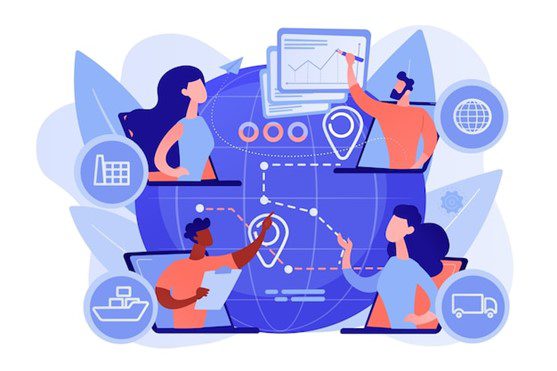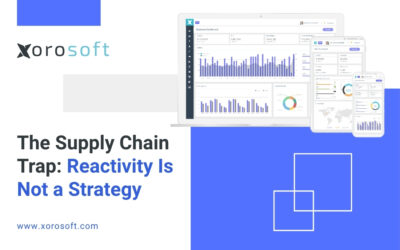
What is an ERP system?
An ERP system is a software solution that integrates and automates various business processes, such as accounting, inventory management, sales, and human resources, into a single, centralized system. By consolidating all your critical business data and functions into one platform, an ERP system can help you streamline operations, improve decision-making, and enhance overall efficiency.
Benefits of implementing an ERP system for small businesses
- Improved data integration and accessibility: ERP systems consolidate data from various departments, making it easier to access and analyze information, leading to more informed decision-making.
- Enhanced efficiency and productivity: Automation of routine tasks and the integration of business processes can help your team work more efficiently, reducing the time and effort required to complete daily operations.
- Better inventory management: ERP systems provide real-time visibility into your inventory levels, allowing you to optimize stock, reduce waste, and improve customer satisfaction.
- Strengthened financial management: ERP systems integrate accounting and financial functions, making it easier to track expenses, generate reports, and manage cash flow.
- Scalability and growth: As your small business expands, an ERP system can grow with you, providing the tools and infrastructure to support your evolving needs.
Common challenges in implementing an ERP system
- Resistance to change: Employees may be hesitant to adapt to a new system, especially if they are comfortable with existing processes.
- Data migration and integration: Transitioning data from legacy systems to the new ERP platform can be a complex and time-consuming process.
- Customization and configuration: ERP systems often require extensive customization to align with your specific business requirements, which can increase the implementation timeline and costs.
- Training and user adoption: Ensuring that your team is proficient in using the ERP system is crucial for its successful implementation and ongoing use.
- Budget and resource constraints: Implementing an ERP system can be a significant investment, and small businesses may face challenges in allocating the necessary financial and human resources.
Key features and functionalities of an ERP system
- Financial management: Accounting, accounts payable and receivable, general ledger, and cash flow management.
- Inventory management: Real-time inventory tracking, stock level monitoring, and automated replenishment.
- Sales and customer relationship management (CRM): Order management, invoicing, and customer information centralization.
- Human resources management: Employee data, payroll, and performance tracking.
- Supply chain management: Procurement, supplier management, and logistics optimization.
- Business intelligence and reporting: Customizable dashboards, analytics, and data-driven insights.
Choosing the right ERP solution for your small business
When selecting an ERP system, consider the following factors:
- Scalability: Ensure the ERP system can grow with your business and accommodate future expansion.
- Industry-specific features: Look for an ERP solution that caters to the unique needs of your industry.
- Ease of use: Choose a user-friendly system that requires minimal training for your team.
- Integration capabilities: Evaluate the ERP system’s ability to seamlessly integrate with your existing software and tools.
- Cloud-based or on-premises: Determine whether a cloud-based or on-premises ERP solution better suits your business needs and IT infrastructure.
- Vendor reputation and support: Research the ERP provider’s track record, customer reviews, and the quality of their implementation and ongoing support services.
Introduction to Xorosoft ERP: A reliable solution for small businesses
Xorosoft ERP is a comprehensive, cloud-based ERP system designed specifically for small and medium-sized businesses. With its intuitive interface and robust features, Xorosoft ERP can help streamline your operations, enhance productivity, and drive business growth.
Streamlining inventory management with an ERP system
Effective inventory management is crucial for small businesses to maintain optimal stock levels, reduce waste, and meet customer demands. Xorosoft ERP’s inventory management module provides real-time visibility into your stock, enabling you to:
- Monitor stock levels: Easily track inventory quantities, locations, and expiration dates to avoid stockouts and overstocking.
- Automate replenishment: Set up automated reorder points and generate purchase orders to maintain optimal inventory levels.
- Manage multiple warehouses: Consolidate and manage inventory across multiple locations, ensuring efficient distribution and fulfillment.
- Generate detailed reports: Access comprehensive inventory reports to make data-driven decisions and optimize your supply chain.
Enhancing accounting processes with an ERP system
Accurate and efficient accounting is the backbone of any successful small business. Xorosoft ERP’s financial management module streamlines your accounting processes, allowing you to:
- Streamline accounts payable and receivable: Automate invoicing, payments, and credit management to improve cash flow and reduce administrative tasks.
- Maintain a centralized general ledger: Consolidate all financial data in a single, secure platform, making it easier to generate accurate reports and comply with regulatory requirements.
- Manage budgets and expenses: Track and analyze your company’s financial performance, enabling better decision-making and resource allocation.
- Integrate with banking and payment gateways: Seamlessly connect your ERP system with your financial institutions and payment processors for seamless transactions and reconciliation.
How Xorosoft ERP can help improve inventory management and accounting
By integrating Xorosoft ERP’s inventory management and accounting modules, you can unlock a powerful synergy that drives efficiency and profitability:
- Accurate stock valuation: Xorosoft ERP automatically updates your general ledger with real-time inventory data, ensuring accurate financial reporting and tax compliance.
- Improved cash flow: Streamlined invoicing, accounts receivable, and inventory management can help you maintain a healthy cash flow and better manage your working capital.
- Enhanced decision-making: Comprehensive reports and analytics across inventory, sales, and financial data provide valuable insights to support strategic business decisions.
- Reduced operational costs: Automation and optimization of inventory and accounting processes can help you minimize overhead expenses and improve overall profitability.
Best practices for a successful ERP implementation
Implementing an ERP system is a significant undertaking, but by following these best practices, you can ensure a smoother transition and maximize the benefits for your small business:
- Establish clear goals and objectives: Clearly define the specific pain points you aim to address and the desired outcomes of the ERP implementation.
- Assemble a dedicated implementation team: Identify key stakeholders from various departments to participate in the ERP implementation process.
- Conduct a thorough needs assessment: Carefully evaluate your current business processes and identify areas that can be improved with the ERP system.
- Develop a comprehensive implementation plan: Create a detailed timeline, budget, and project management strategy to guide the implementation process.
- Provide comprehensive user training: Invest in training your team to ensure they are proficient in using the ERP system and its features.
- Continuously monitor and optimize: Regularly review the ERP system’s performance and make necessary adjustments to optimize its effectiveness.
Considerations for integrating an ERP system with existing business processes
Integrating an ERP system with your existing business processes can be a complex task, but it is essential for ensuring a seamless transition and maximizing the system’s benefits. Here are some key considerations:
- Data migration: Develop a comprehensive data migration plan to transfer your critical business data from legacy systems to the new ERP platform.
- Process mapping: Carefully map your current business processes and identify areas where the ERP system can streamline or improve operations.
- Customization and configuration: Work closely with your ERP provider to customize the system to align with your unique business requirements and workflows.
- Change management: Develop a robust change management strategy to help your team adapt to the new ERP system and overcome any resistance to change.
- Ongoing support and maintenance: Ensure that you have access to reliable post-implementation support and resources to address any issues or concerns that may arise.
Overcoming resistance to change during ERP implementation
Resistance to change is a common challenge during ERP implementation, as employees may be reluctant to adapt to new systems and processes. To overcome this, consider the following strategies:
- Communicate the benefits: Clearly explain to your team how the ERP system will improve their day-to-day work and benefit the overall business.
- Involve employees in the process: Encourage active participation and feedback from your team throughout the implementation process.
- Provide comprehensive training: Invest in thorough training programs to ensure your employees are comfortable and proficient in using the ERP system.
- Recognize and reward adoption: Acknowledge and celebrate employees who embrace the new ERP system and champion its use within the organization.
- Address concerns and resistance: Be proactive in addressing any fears or concerns your team may have about the ERP implementation.
Training and support for ERP system users
Ensuring your team is well-trained and supported in using the ERP system is crucial for its long-term success. Consider the following strategies:
- Comprehensive training programs: Develop a training curriculum that covers all the key features and functionalities of the ERP system, tailored to the specific needs of each department or role.
- Ongoing support and resources: Provide your team with a dedicated support team, user manuals, and online resources to help them navigate the ERP system and address any issues that may arise.
- Continuous learning and development: Offer regular training sessions and workshops to help your employees stay up-to-date with the latest ERP system features and best practices.
- Feedback and continuous improvement: Encourage your team to provide feedback and suggestions for improving the ERP system’s usability and effectiveness.
The cost of implementing an ERP system
The cost of implementing an ERP system can vary widely depending on several factors, including the size of your business, the complexity of your operations, the specific features and functionalities required, and the implementation approach (on-premises or cloud-based). Generally, the costs associated with ERP implementation can be categorized as follows:
- Software licensing and subscription fees: The cost of the ERP software itself, which may be a one-time purchase or an ongoing subscription.
- Hardware and infrastructure: If you opt for an on-premises ERP solution, you’ll need to factor in the cost of servers, storage, and other hardware components.
- Implementation and customization: The fees charged by the ERP provider or a third-party consultant for the implementation, configuration, and customization of the system to meet your specific business needs.
- Training and change management: The cost of providing comprehensive training to your team and managing the organizational change associated with the ERP implementation.
- Ongoing maintenance and support: The annual fees for software updates, technical support, and any additional services required to keep the ERP system running smoothly.
It’s important to work closely with your ERP provider to understand the full scope of the implementation and the associated costs, as well as explore any available financing or subscription-based options that may better fit your small business budget.
Conclusion: Taking the first step towards implementing an ERP system for your small business
Implementing an ERP system can be a transformative step for your small business, offering a range of benefits that can help you streamline operations, improve decision-making, and drive growth. While the process may seem daunting, by following best practices, addressing common challenges, and partnering with the right ERP provider, you can successfully navigate the implementation and unlock the full potential of this powerful technology.
If you’re ready to take the first step towards implementing an ERP system for your small business, Book a demo with xorosoft to explore how our comprehensive, cloud-based solution can help you achieve your goals. Our team of experts is here to guide you through the process and ensure a seamless transition to a more efficient, data-driven, and profitable future.









